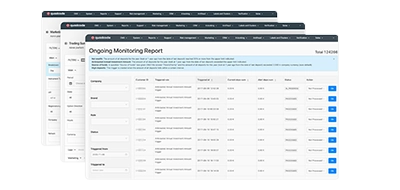Voltar
Contents
Padrões Harmônicos para Traders: Seu Guia Completo para Negociações Lucrativas


Demetris Makrides
Senior Business Development Manager

Vitaly Makarenko
Chief Commercial Officer
Padrões harmônicos são padrões geométricos de preços, formados por padrões bem definidos baseados na razão de Fibonacci, que ajudam os traders a identificar potenciais pontos de reversão com maior precisão. Esses padrões matemáticos utilizam estruturas únicas de preço e tempo para prever onde os mercados podem reverter, proporcionando a você uma vantagem significativa na decisão de negociação.
O que são padrões harmônicos?
Os padrões harmônicos são um método complexo de análise técnica. Integram geometria, matemática e psicologia de mercado para antecipar padrões de preços previsíveis. Ao contrário dos padrões gráficos convencionais, os padrões harmônicos dependem de dados precisos. Razões de Fibonacci para confirmar seu padrão.
A premissa subjacente da negociação harmônica é que os mercados operam em ciclos identificáveis. Esses ciclos formam padrões geométricos únicos que se repetem em diferentes períodos e ambientes de mercado.
A Fundação Matemática
Todos os padrões harmônicos devem operar sob regras matemáticas estritas. Os padrões devem atender a certas Retração de Fibonacci e níveis de extensão para serem válidos. Esse nível de precisão matemática é o que coloca os padrões harmônicos à frente de outras ferramentas técnicas.
As proporções de Fibonacci mais amplamente utilizadas aplicadas em padrões harmônicos são:
- 0,382 (38,2%)
- 0,618 (61,8%)
- 0,786 (78,6%)
- 1.272 (127,2%)
- 1.618 (161,8%)
A estrutura XABCD explicada
Os padrões harmônicos se enquadram na estrutura XABCD, composta por cinco pontos-chave (X, A, B, C e D) e que utiliza extensões e retrações de Fibonacci. Entender essa estrutura é crucial para a identificação e negociação bem-sucedidas dos padrões.
Decompondo cada ponto
- Ponto X: Onde o padrão começa
- Ponto A: O primeiro movimento significativo de preço de X
- Ponto B: O recuo do ponto A (geralmente 61,8% ou 78,6%)
- Ponto C: O movimento do ponto B (geralmente 38,2% a 88,6% de AB)
- Ponto D: Onde você coloca as negociações para conclusão
A Zona de Conclusão de Padrão (PRZ) é estabelecida em torno do ponto D. Este é o local ideal para entrar em negociações com base na previsão do padrão harmônico.
Principais padrões harmônicos que todo trader deve conhecer
O Padrão Gartley
O padrão de Gartley é comumente conhecido como o "avô" dos padrões harmônicos. Foi descoberto por HM Gartley em 1935 e continua sendo uma das formas mais confiáveis.
Proporções:
- Retração AB: 61,8% de XA
- Retração BC: 38,2% a 88,6% de AB
- Extensão do CD: 127,2% a 161,8% do BC
- Retração AD: 78,6% de XA
Estratégia de negociação: Compre no ponto D com stop loss abaixo da zona de conclusão. Realize lucro nas retrações de 38,2% e 61,8% da perna AD.
O Padrão da Borboleta
O padrão Borboleta se estende além do ponto X, criando uma zona de reversão mais ampla. O padrão Borboleta geralmente sugere reversões potenciais mais fortes.
Índices-chave:
- Retração AB: 78,6% de XA
- Retração BC: 38,2% a 88,6% de AB
- Extensão do CD: 161,8% a 224% do BC
- Extensão AD: 127,2% a 161,8% de XA
Abordagem de negociação: O padrão Borboleta exige paciência. Aguarde sinais de confirmação sólidos antes de entrar, pois pode haver repetidos rompimentos falsos.
O Padrão do Morcego
O padrão Bat é semelhante ao Gartley, mas com proporções variadas. É mais preciso e oferece níveis de stop-loss mais restritos.
Índices-chave:
- Retração AB: 38,2% a 50% de XA
- Retração BC: 38,2% a 88,6% de AB
- Extensão do CD: 161,8% a 261,8% do BC
- Retração AD: 88,6% de XA
O Padrão do Caranguejo
O Caranguejo é o padrão harmônico mais extremo. Ele se desvia mais do ponto inicial e normalmente forma as reversões mais fortes.
Índices-chave:
- Retração AB: 38,2% a 61,8% de XA
- Retração BC: 38,2% a 88,6% de AB
- Extensão do CD: 224% a 361,8% do BC
- Extensão AD: 161,8% de XA
O Padrão Tubarão
O padrão Shark se destaca por não seguir o padrão XABCD típico. Ele segue uma maneira diferente de detectar zonas de reversão.
Principais características:
- A primeira etapa se estende de 113% para 161,8% de extensão
- Segunda etapa retraça 161,8% a 224% da primeira etapa
- Conclusão em níveis de 88,6% a 113%
Como negociar padrões harmônicos com sucesso
Etapa 1: Identificação de padrões
Comece analisando seus gráficos em busca de um possível padrão harmônico. Procure por pontos X e A bem definidos que marquem a direção da tendência inicial. Use software de reconhecimento de padrões ou ferramentas de indicadores para ajudar a localizar esses padrões automaticamente.
Etapa 2: Verifique o padrão
Depois de localizar um padrão potencial, verifique se ele atende exatamente aos requisitos de Fibonacci. Cada padrão também possui requisitos matemáticos rigorosos que devem ser atendidos para que a formação seja válida.
Etapa 3: Aguarde a conclusão
Muita paciência aqui. Aguarde até que o padrão seja concluído no ponto D antes de entrar em operações. Entrada antecipada significa perdas.
Etapa 4: Confirme a reversão
Procure por confirmações adicionais, como padrões de velas, divergências ou outros indicadores técnicos alinhados com a Zona de Conclusão de Padrões (PRZ).
Sinais de confirmação adicionais são:
- Divergência de alta ou baixa no RSI ou MACD
- Padrões de velas de reversão (doji, martelo, estrela cadente)
- Aumento de volume na zona de conclusão
- Nível de suporte ou resistência no ponto D
Etapa 5: Controle seu risco
Coloque seu stop loss fora da zona de conclusão. Para tendências de alta, coloque os stops abaixo do ponto D. Para tendências de baixa, coloque os stops acima do ponto D. Este método fornece ao padrão espaço para operar, ao mesmo tempo que restringe o risco de queda.
Etapa 6: Obtenha lucros estrategicamente
Tenha uma estratégia de saída antes de entrar na operação. Metas de lucro populares são:
- Retração de 38,2% da perna do CD
- Retração de 61,8% da perna do CD
- Nível do ponto C
- Nível do Ponto A (em movimentos mais longos)
Técnicas Avançadas de Negociação Harmônica
Análise de múltiplos períodos de tempo
Compare padrões harmônicos em diferentes períodos para aumentar a precisão. Um padrão em formação em um gráfico diário é mais importante do que um gráfico de 5 minutos.
Confluência de padrões
Procure locais onde mais de um padrão harmônico conflua no mesmo ponto de preço. Essa confluência criará fortes áreas de reversão com maior probabilidade de negociação.
Colaboração com outros indicadores
Finalize sua negociação harmônica adicionando outros indicadores técnicos:
- Médias móveis para confirmar a tendência
- Indicadores de volume para confirmar a força
- Osciladores de momento para confirmação de divergência
Como evitar erros comuns na negociação de padrões harmônicos
Padrões de Força
Não tente aplicar padrões não Fibonacci. Isso gera sinais falsos e operações perdedoras.
Negligência do contexto de mercado
Certifique-se de considerar o contexto geral do mercado. Padrões harmônicos funcionam melhor em mercados com variações ou tendências, não em eventos noticiosos significativos ou períodos de alta volatilidade.
Má gestão de riscos
Não arrisque mais do que 1-2% da sua conta em qualquer negociação com padrão harmônico. A altíssima precisão desses padrões não garante o sucesso.
Impaciência
Padrões harmônicos são um processo lento de formação e conclusão. Entrar em negociações prematuramente costuma ser uma receita para a ruína.
Dicas sobre a aplicação da negociação harmônica
Melhores mercados para negociação harmônica
Os padrões harmônicos são melhor aplicados a:
- Mercados Forex (alta liquidez, tendências limpas)
- Índices de ações (níveis de suporte/resistência bem estabelecidos)
- Ações individuais (suporte fundamental firme)
- Mercados de criptomoedas (alta volatilidade, padrões limpos)
Prazos ideais
Negociação com prazos adequados ao seu estilo de negociação:
- Day traders: gráficos de 15 minutos a 1 hora
- Swing traders: gráficos de 4 horas a diários
- Operadores de posição: gráficos diários e semanais
Ferramentas e Recursos
Utilize qualquer uma das seguintes ferramentas para aumentar sua negociação harmônica:
- Software de reconhecimento de padrões harmônicos
- Ferramentas de desenho de Fibonacci
- Alertas de conclusão de padrão
- Plataformas de backtesting de validação de estratégia
A psicologia por trás dos padrões harmônicos
Compreender a psicologia do mercado simplifica o sucesso dos padrões harmônicos. Esses padrões são as ações coletivas dos participantes do mercado em relação a uma condição específica.
Ciclos de Sentimento do Mercado
Cada ponto do padrão harmônico representa uma mudança no sentimento do mercado:
- Ponto X a A: Estabelecimento de tendência inicial
- Ponto A a B: Realização de lucro e retração
- Ponto B a C: Interesse renovado na tendência
- Ponto C a D: Esgotamento final e configuração de reversão
Psicologia de Fibonacci
As taxas de Fibonacci são utilizadas por traders em todo o mundo, induzindo profecias autorrealizáveis. Sempre que há grandes expectativas dos traders por reversões em níveis específicos de Fibonacci, esses níveis se tornam pontos de inflexão significativos.
Como medir o sucesso e o desempenho
Métricas-chave de desempenho
Acompanhe as seguintes métricas para medir seu desempenho de negociação harmônica:
- Taxa de vitória (meta de 60-70%)
- Relação risco-recompensa (meta 1:2 ou melhor)
- Duração média de retenção
- Rebaixamento máximo
- Fator de lucro
Melhoria Contínua
Mantenha um diário de negociações anotando:
- Tipos de padrões negociados
- Condições de mercado durante a negociação
- Motivos de entrada e saída
- Lições aprendidas em cada negociação
Como integrar a negociação harmônica com a negociação moderna
Negociação Algorítmica
Muitos traders institucionais agora usam algoritmos para detectar e negociar padrões harmônicos automaticamente. Essa automação crescente tornou os padrões mais eficientes e competitivos.
Impacto do Comércio Social
O advento dos sites de negociação social internacionalizou o treinamento em padrões harmônicos para traders de varejo. A democratização não apenas aumentou o reconhecimento de padrões, como também fechou algumas oportunidades de vantagem competitiva.
Como gerenciar riscos na negociação harmônica
Dimensionamento de posição
Defina o tamanho das posições em função da distância entre o stop e a entrada. Nunca arrisque mais do que você pode perder em qualquer operação.
Análise de correlação
Tenha cuidado com as correlações entre diferentes mercados ao negociar múltiplos padrões harmônicos simultaneamente. Evite a superexposição a ativos altamente correlacionados.
Avaliação da Condição de Mercado
Avalie as condições de mercado prevalecentes antes de negociar padrões harmônicos:
- Mercados em alta: padrões de continuidade de negociação
- Mercados de variação: padrões de reversão de negociação
- Mercados voláteis: use paradas maiores e posições menores
Conclusão
Padrões harmônicos proporcionam uma vantagem matemática na negociação, combinando índices de Fibonacci corretos com psicologia de mercado determinável. Embora seja necessária prática paciente para dominar esses padrões, eles podem aumentar significativamente seu nível de precisão como trader, se usados corretamente. Lembre-se de que nem todo padrão é garantia – sua vantagem vem do uso diligente de uma boa gestão de risco, confirmação rigorosa de padrões e autodisciplina constante. Comece com contas demo, priorize a qualidade em vez da quantidade e aumente sua confiança à medida que aprende a desenvolver seu reconhecimento de padrões. O segredo para o sucesso a longo prazo é tratar os padrões harmônicos como uma das ferramentas em sua caixa de ferramentas de negociação e não como uma solução mágica.
FAQ
Padrões harmônicos geralmente apresentam taxas de sucesso de 60 a 80% quando identificados e negociados corretamente. O sucesso depende da execução adequada, da gestão de riscos e das condições de mercado.
A maioria dos traders precisa de 6 a 12 meses de prática consistente para se tornar proficiente na identificação e negociação de padrões harmônicos. A proficiência leva alguns anos de estudo e prática sérios.
Sim, padrões harmônicos funcionam em todos os períodos. No entanto, padrões em períodos mais longos (diários, semanais) são mais confiáveis do que em períodos extremamente curtos (1 minuto, 5 minutos).
Padrões harmônicos funcionam melhor em mercados com tendências ou variações. Funcionam menos bem durante grandes eventos de notícias, anúncios de lucros ou períodos de extrema volatilidade.
Os padrões harmônicos dependem de proporções precisas de Fibonacci e precisão matemática, enquanto os padrões gráficos típicos são relativos e baseados em formas e configurações gerais.
Um padrão harmônico só será válido se atender aos requisitos específicos da razão de Fibonacci em cada perna. Faça medições meticulosas com equipamentos de medição adequados e verifique cada ponto de retração e extensão antes de aceitar o padrão como válido.
Não, negocie apenas padrões de alta qualidade que atendam a todos os requisitos e forneçam sinais de confirmação adicionais. Qualidade em vez de quantidade para sucesso a longo prazo.
Sim, os padrões harmônicos integram-se bem com outros métodos de análise técnica, sistemas de acompanhamento de tendências e análise fundamentalista. O segredo é garantir que os métodos se complementem, e não se contradigam.
Atualizado:
7 de julho de 2025




